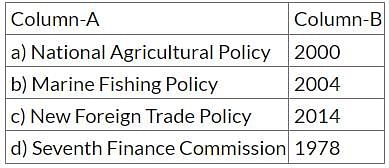UPPSC Prelims (GS I) Mock Test - 9 - UPPSC (UP) MCQ
30 Questions MCQ Test - UPPSC Prelims (GS I) Mock Test - 9
Consider the following statements:
- A bill amending the Constitution requires a prior recommendation of the President of India.
- When a Constitution Amendment Bill is presented to the President of India, it is obligatory for the President of India to give his/her assent.
- A Constitution Amendment Bill must be passed by both the Lok Sabha and Rajya Sabha by a special majority and there is no provision for joint sitting.
Which of the statements given above are correct?
In the context of Indian history, the Rakhmabai case of 1884 revolved around.
- women's right to gain an education.
- age of consent.
- restitution of conjugal rights.
Select the correct answer using the code given below:
| 1 Crore+ students have signed up on EduRev. Have you? Download the App |
Between which two countries is Exercise Samudra Laksamana strengthening maritime cooperation?
Which of the following statements are correct about 'International Convention for the Prevention of Pollution from Ships (MARPOL)':
- It was convened under the UNFCCC.
- The Convention includes regulations aimed at preventing and minimizing pollution from ships.
- India is a signatory to MARPOL.
Select the correct answer using the codes given below.
Identify the crop on the basis of the following characteristics:
- India is the seventh-largest producer worldwide.
- It is used both as food and fodder.
- The top Producing State in India is Karnataka.
Select the correct answer using the code given below:
If a Panchayat is dissolved, elections are to be held within ________.
Which of the following is NOT a chemical change?
Match Column-A with Column-B and select the correct answer using the codes given below.

Match list-I with list-II and choose the correct answer from the code given below -

Which sports category did Divyakriti Singh receive the Arjuna Award for, making her the first woman from Rajasthan to achieve this honour?
Who has been appointed as the new Director General of the National Security Guard (NSG)?
Where is the 'Tawi Festival' scheduled to take place for four days starting March 1, 2024?
Which of the following is a device for growing plants in a controlled environment?
With reference to Mughal India, what is/are the difference/differences between Jagirdar and Zamindar?
- Jagirdars were holders of land assignments in lieu of judicial and police duties, whereas Zamindars were holders of revenue rights without obligation to perform any duty other than revenue collection.
- Land assignments to Jagirdars were hereditary and revenue rights of Zamindars were not hereditary.
Select the correct answer using the code given below:
Which of the following is not the objective of games and sports?
When the same amount of zinc is treated separately with excess of sulphuric acid and excess of sodium hydroxide, the ratio of volumes of hydrogen evolved is:
Mogao Caves, also known as “Caves of the Thousand Buddhas” are located in which among the following countries?
National Air Quality Index is a measure of which among the following pollutants?
Auppatik and Avasyaka Sutras describe the religious ideas of which king?
Which ruler introduced the “Tri Metal Coinage” system which later became the Mughal coinage system?
Consider the following about the Bhashini initiative:
1. Bhashini aims to enable all Indians easy access to the Internet and digital services in their own language and increase the content in Indian languages.
2. This online platform also has a separate Bhasadaan section which allows individuals to contribute to multiple crowdsourcing initiatives.
Which of the statements given above is/are correct?
Consider the following statements (A) and (R).
(A): The Constitution of India recognizes the right to water as being a part of the right to life under Article 21.
(R): Every person should have universal access to water.
Choose the correct option:
Which of the following mountains is located near the river Dhauliganga?
Which governor was the last governor of the United Province under British rule in India before Independence?
Which of the following is not correct about National Commission for Scheduled Castes?
The characteristic of the unorganized sector in an economy is _______.
What is the maximum fine imposed by the National Green Tribunal for bulk waste dumping in Uttar Pradesh after the first violation?
Which river is significant for its cultural and historical importance in Ayodhya?
How many defence manufacturing deals did the Uttar Pradesh government recently sign, and what is their estimated value?



















